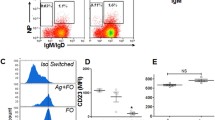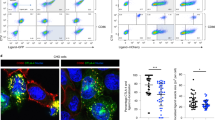Abstract
A homozygous mutation in a splice site of the CD81 gene was identified previously in a patient, as the cause in a case of common variable immune deficiency (CVID). CD19 expression is reduced in mice that lack CD81; however, B cells in this patient lacked completely CD19 surface expression. The mutation led to an absence of the CD81 protein on the cell surface and it was assumed that the CD81 protein was not produced. Here we demonstrate that a truncated human CD81 mutant (CD81mut) was actually produced, but retained intracellularly. We also demonstrate that the truncated CD81mut protein is in close proximity to the intracellularly sequestered CD19. However, this interaction does not enable normal CD19 maturation and surface expression. In addition, we show that specific domains of CD81 enable retrieval and trafficking of human CD19 to the cell surface. Finally, we demonstrate that surface expression of CD19 requires CD81, even in non-B cells.





Similar content being viewed by others
References
Shoham T, Rajapaksa R, Boucheix C, Rubinstein E, Poe JC, Tedder TF, et al. The tetraspanin CD81 regulates the expression of CD19 during B cell development in a postendoplasmic reticulum compartment. J Immunol. 2003;171(8):4062–72.
Miyazaki T, Muller U, Campbell KS. Normal development but differentially altered proliferative responses of lymphocytes in mice lacking CD81. Embo J. 1997;16(14):4217–25.
Tsitsikov EN, Gutierrez-Ramos JC, Geha RS. Impaired CD19 expression and signaling, enhanced antibody response to type II T independent antigen and reduction of B-1 cells in CD81-deficient mice. Proc Natl Acad Sci U S A. 1997;94(20):10844–9.
Maecker HT, Levy S. Normal lymphocyte development but delayed humoral immune response in CD81-null mice. J Exp Med. 1997;185(8):1505–10.
van Zelm MC, Smet J, Adams B, Mascart F, Schandene L, Janssen F, et al. CD81 gene defect in humans disrupts CD19 complex formation and leads to antibody deficiency. J Clin Invest. 2010;120(4):1265–74.
van Zelm MC, Reisli I, van der Burg M, Castano D, van Noesel CJ, van Tol MJ, et al. An antibody-deficiency syndrome due to mutations in the CD19 gene. N Engl J Med. 2006;354(18):1901–12.
Kanegane H, Agematsu K, Futatani T, Sira MM, Suga K, Sekiguchi T, et al. Novel mutations in a Japanese patient with CD19 deficiency. Genes Immun. 2007;8(8):663–70.
Tedder TF. CD19: a promising B cell target for rheumatoid arthritis. Nat Rev Rheumatol. 2009;5(10):572–7.
Sato S, Steeber DA, Jansen PJ, Tedder TF. CD19 expression levels regulate B lymphocyte development: human CD19 restores normal function in mice lacking endogenous CD19. J Immunol. 1997;158(10):4662–9.
Bradbury LE, Goldmacher VS, Tedder TF. The CD19 signal transduction complex of B lymphocytes. Deletion of the CD19 cytoplasmic domain alters signal transduction but not complex formation with TAPA-1 and Leu 13. J Immunol. 1993;151(6):2915–27.
Bradbury LE, Kansas GS, Levy S, Evans RL, Tedder TF. The CD19/CD21 signal transducing complex of human B lymphocytes includes the target of antiproliferative antibody-1 and Leu-13 molecules. J Immunol. 1992;149(9):2841–50.
Matsumoto AK, Martin DR, Carter RH, Klickstein LB, Ahearn JM, Fearon DT. Functional dissection of the CD21/CD19/TAPA-1/Leu-13 complex of B lymphocytes. J Exp Med. 1993;178(4):1407–17.
Fearon DT, Carroll MC. Regulation of B lymphocyte responses to foreign and self-antigens by the CD19/CD21 complex. Annu Rev Immunol. 2000;18:393–422.
Sato S, Miller AS, Howard MC, Tedder TF. Regulation of B lymphocyte development and activation by the CD19/CD21/CD81/Leu 13 complex requires the cytoplasmic domain of CD19. J Immunol. 1997;159(7):3278–87.
Rocha-Perugini V, Lavie M, Delgrange D, Canton J, Pillez A, Potel J, et al. The association of CD81 with tetraspanin-enriched microdomains is not essential for Hepatitis C virus entry. BMC Microbiol. 2009;9:111.
Higginbottom A, Quinn ER, Kuo CC, Flint M, Wilson LH, Bianchi E, et al. Identification of amino acid residues in CD81 critical for interaction with hepatitis C virus envelope glycoprotein E2. J Virol. 2000;74(8):3642–9.
Shoham T, Rajapaksa R, Kuo CC, Haimovich J, Levy S. Building of the tetraspanin web: distinct structural domains of CD81 function in different cellular compartments. Mol Cell Biol. 2006;26(4):1373–85.
Rocha-Perugini V, Zamai M, Gonzalez-Granado JM, Barreiro O, Tejera E, Yanez-Mo M, et al. CD81 controls sustained T cell activation signaling and defines the maturation stages of cognate immunological synapses. Mol Cell Biol. 2013;33(18):3644–58.
Harman C, Zhong L, Ma L, Liu P, Deng L, Zhao Z, et al. A View of the E2-CD81 Interface at the Binding Site of a Neutralizing Antibody against Hepatitis C Virus. J Virol. 2015;89(1):492–501.
Kitadokoro K, Bordo D, Galli G, Petracca R, Falugi F, Abrignani S, et al. CD81 extracellular domain 3D structure: insight into the tetraspanin superfamily structural motifs. Embo J. 2001;20(1–2):12–8.
Soderberg O, Gullberg M, Jarvius M, Ridderstrale K, Leuchowius KJ, Jarvius J, et al. Direct observation of individual endogenous protein complexes in situ by proximity ligation. Nat Methods. 2006;3(12):995–1000.
Levy S, Shoham T. The tetraspanin web modulates immune-signalling complexes. Nat Rev Immunol. 2005;5(2):136–48.
Engel P, Zhou LJ, Ord DC, Sato S, Koller B, Tedder TF. Abnormal B lymphocyte development, activation, and differentiation in mice that lack or overexpress the CD19 signal transduction molecule. Immunity. 1995;3(1):39–50.
Homsi Y, Schloetel JG, Scheffer KD, Schmidt TH, Destainville N, Florin L, et al. The extracellular delta-domain is essential for the formation of CD81 tetraspanin webs. Biophys J. 2014;107(1):100–13.
Russ WP, Engelman DM. The GxxxG motif: a framework for transmembrane helix-helix association. J Mol Biol. 2000;296(3):911–9.
Berditchevski F, Odintsova E. Tetraspanins as regulators of protein trafficking. Traffic. 2007;8(2):89–96.
Manolios N, Bonifacino JS, Klausner RD. Transmembrane helical interactions and the assembly of the T cell receptor complex. Science. 1990;249(4966):274–7.
Fink A, Sal-Man N, Gerber D, Shai Y. Transmembrane domains interactions within the membrane milieu: principles, advances and challenges. Biochim Biophys Acta. 2012;1818(4):974–83.
Seigneuret M. Complete predicted three-dimensional structure of the facilitator transmembrane protein and hepatitis C virus receptor CD81: conserved and variable structural domains in the tetraspanin superfamily. Biophys J. 2006;90(1):212–27.
Dornier E, Coumailleau F, Ottavi JF, Moretti J, Boucheix C, Mauduit P, et al. TspanC8 tetraspanins regulate ADAM10/Kuzbanian trafficking and promote Notch activation in flies and mammals. J Cell Biol. 2012;199(3):481–96.
Haining EJ, Yang J, Bailey RL, Khan K, Collier R, Tsai S, et al. The TspanC8 subgroup of tetraspanins interacts with A disintegrin and metalloprotease 10 (ADAM10) and regulates its maturation and cell surface expression. J Biol Chem. 2012;287(47):39753–65.
Prox J, Willenbrock M, Weber S, Lehmann T, Schmidt-Arras D, Schwanbeck R, et al. Tetraspanin15 regulates cellular trafficking and activity of the ectodomain sheddase ADAM10. Cell Mol Life Sci. 2012;69(17):2919–32.
Acknowledgments
We thank Dr. Ronald Levy for critically editing the manuscript, Dr. Laurence Cocquerel for the hepatocyte Huh-7 CD81POS and Huh-7w7 CD81NEG cell lines, Debra Czerwinski for help with flow cytometric analyses and Dr. Francisco Sanchez Madrid for CD81shRNA.
Disclosure of conflict of interest
None of the authors have a conflict of interest.
Authorship contribution
FVC and CCK contributed equally to this work. FVC, CCK, YS, HC and NKM designed, performed and collected data, MCvZ and JMvD EBV-transformed and generated the patient’s B cell line, SL, FVC and YS designed the research, analyzed the data and wrote the manuscript.
Supported by a Specialized Center of Research (SCOR) grant from the Leukemia and Lymphoma Society.
Author information
Authors and Affiliations
Corresponding author
Rights and permissions
About this article
Cite this article
Vences-Catalán, F., Kuo, CC., Sagi, Y. et al. A mutation in the human tetraspanin CD81 gene is expressed as a truncated protein but does not enable CD19 maturation and cell surface expression. J Clin Immunol 35, 254–263 (2015). https://doi.org/10.1007/s10875-015-0148-2
Received:
Accepted:
Published:
Issue Date:
DOI: https://doi.org/10.1007/s10875-015-0148-2




